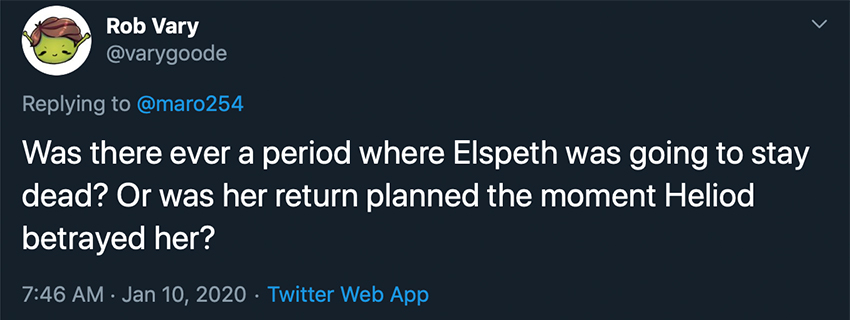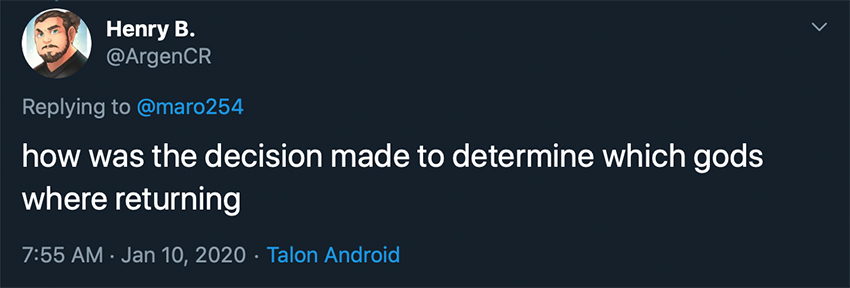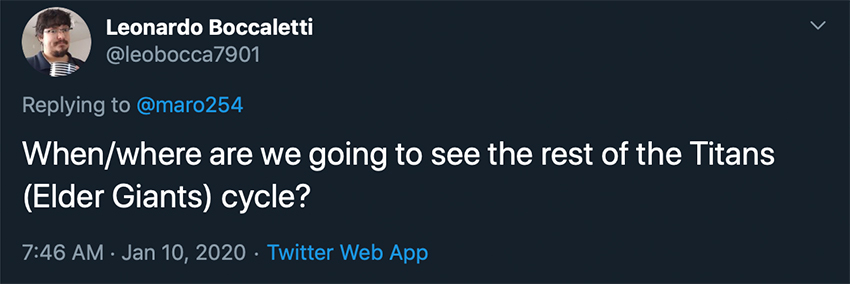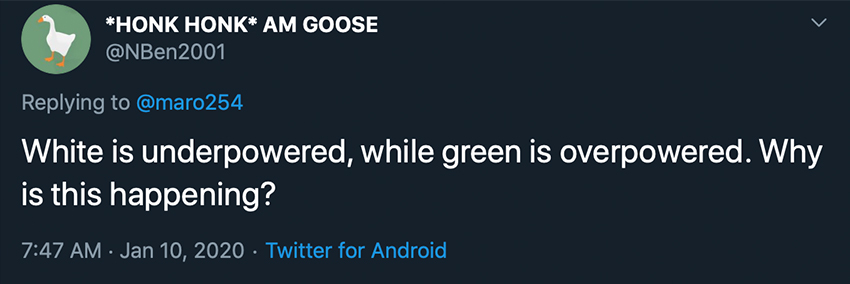Odds & Ends: Theros Beyond Death
Every set, I like to do a mailbag column or two where I answer all your questions about the set. Today, I'll be talking about Theros Beyond Death.
Here's the tweet I posted:
It's time for me to write a mailbag column about #mtgtbh. Please keep your questions about Theros Beyond Death to a single tweet, one question per tweet. Thanks. #WotCStaff
— Mark Rosewater (@maro254) January 10, 2020
As always, I'll try to answer as many questions as I can, but here's why I might not answer your question:
- I have an allotted word count, which means that there are only so many questions I can get to.
- Someone else might have asked the same question. I will usually answer the first person who asks.
- Some questions I either don't know the answer to or don't feel qualified enough in the area to properly answer.
- Some topics I'm not allowed to answer for all sorts of reasons, including previews for future sets.
Per tradition, I'm going to start with the most asked question:

I got this question quite a bit, so I wanted to call in someone from our Franchise team with firsthand knowledge of our long-range story plans. For those who don't know, we reorganized a bit in late 2018, and part of that reorganization was the creation of the Franchise team, which leads our story expressions and how they get to you. Jeremy Jarvis is our Franchise Creative Director, which makes him a great one to answer this question once and for all:
"What you’re seeing is Magic’s Franchise team testing and learning. Starting with Dominaria fiction we increased our investment and ambition in how we want to delivery great story to our fans. What if we were able to build a talent pool of authors that mirrored our talent pool of illustrators? What new delivery channels could we use to expand the reach of our fiction?
"Since Dominaria, you’ve seen us expand our author pool, enter into new licensed partnerships for comics and novels, and vary both the number of stories released and the length of those stories. We want to best understand the tone that works for our audience as well as the specific content that resonates most successfully in any given narrative expression (short form vs. comics vs. long form, for example). To do that we have to create opportunities to test and learn.
"With Wildered Quest, we released our first new-era ePub through Penguin Random House. It was more successful than anticipated and was well received. The blowback from Forsaken illuminated that we needed a better validation strategy not only for issues of representation, but for narrative content in general; so we made the hard call to delay Theros Beyond Death fiction until we could create a new vetting process. That unfortunately meant that we would miss our intended release window. We did our best to leverage our preview plans and marketing support to deliver the broad strokes of the story so people weren’t left completely in the lurch, but we know you are disappointed and we are too. We’re doing everything we can to ensure this will be a one-time cost for a smoother future.
"With Ikoria we will return to an ePub strategy, and we will also find the correct time and channel to release the Theros Beyond Death fiction. Maybe it will be part of an anthology, or direct to Audible, or as a graphic novel.
"Magic fandom deserves a publishing program as robust and enjoyable as the TCG, and Magic’s Franchise Team is committed to delivering exactly that. In the meantime, don’t be dismayed when you see us try new things. Don’t be shy in telling us when something doesn’t work (imagine a big smiley face emoji when I say that historically this hasn’t been an issue), but, more importantly, make sure you tell us what you love. That’s what we want to deliver."
-Jeremy Jarvis

With any return, we want to make sure that the set feels like you're going back to the world, which means mechanically, we want to have some connection with what happened last time we were there. Usually, what that entails is early in vision design (and sometimes during exploratory design), we write up every single mechanic and theme that showed up in previous visits. For sets that we last visited in a block, especially a three-set block like Theros, that's a lot of stuff. We then go through all the items and break them into three categories. One—things the audience loved and would expect to be there in a return. Two—things the players hate and would not be happy to see return. And three—things that players liked and wouldn't mind seeing again, but wouldn't cause great distress if we left out.
If the first box is full, usually that's what you're going to use, and even some of that might have to get trimmed down. If the first box is light, you look at the third box to see what's there that might be useful to help supplement. If the first and third box are light, you have to start thinking a bit "outside the boxes." Usually, though, if the world is a place players want to return to, there's enough mechanical meat to work with.
The tricky part is that you want to have something new in your set (usually new ways to explore old themes, but sometimes there could be a whole new aspect to the plane such as with the Underworld), so you only have so much space to bring back old stuff. This means that you have to make hard choices about what to bring back and what not to bring back. And remember, what the audience loves about a world will differ from person to person. Anything you leave out is someone's favorite part of the world. The key is to think big picture and try to maximize your choices to make as much of the audience as happy as you can.
With Theros, we decided that the three most important things were Gods, devotion, and an "enchantments matter" theme (which brings with it a need for enchantment creatures). Those were the things that we felt would just make Theros not feel like Theros if they weren't there. We didn't walk into it believing the "enchantments matter" keyword had to be constellation, but after trying a lot of other things, came to the conclusion that we'd got it correct the first time (although with the tweak that not all constellation cards would be enchantments this time).
This is one of the hardest things to do when designing a return. Knowing what needs to be there versus recognizing what you simply want to be there can cause many hours of work and discussion.

Elspeth's eventual escape was built into the decision to kill her in the original Theros block story. Because we were trying to tell a very Greek mythology-style story, we knew that Heliod had to kill her, but the existence of an underworld allowed us the ability to do that without permanently losing Elspeth. It just meant we'd be taking her out of the story for a while. Though there never was a time where we thought that she'd stay dead. You might note in the Theros novella, we went to great lengths to explain how the Underworld worked and had Elspeth die specifically on Theros (unlike Xenagos who died in Nyx and thus didn't go to the Underworld).

As I explained above, we knew we couldn't return to Theros without having Gods. We also knew that fifteen Gods would be too many. There was a lot of discussion during Journey into Nyx design, at the end of the block, that we'd bitten off a little more than we could handle, and that if we had the whole block to do over again, we'd have less than fifteen Gods. If we had trouble fitting them in three sets, they for sure weren't going to fit in one. The question was how many could we fit?
From a story perspective, we needed Heliod and Erebos, and we knew we'd have to reference Athreos as the Underworld played a big role in the story. We ended up deciding to just do the cycle of the five monocolored "major" Gods. Monocolored cards are easier to get into more decks, and the monocolored ones were the biggest Gods from a cosmology perspective. We decided to make Athreos the Buy-a-Box card as a way to get him into the set without being in Draft booster packs.
Klothys came about because the previous story made a big deal about the missing red-green God. It's the slot Xenagos took when he ascended to godhood. The players had focused a lot on it, and we realized it would be the opportunity to make a desired card. The idea of having Klothys trapped in the Underworld thematically fit the set and explained the absence in the previous block. That was seven Gods. We were confident that would feel like enough.

A couple of reasons:
One, we had just come off a year where we'd stayed on a plane for three consecutive sets. It was an odd message for us to be moving away from blocks and then basically have a year that felt very similar to the old block structure. That meant that we wanted to make the next year's mix of sets strongly message the new system and felt the best way to do that was to have three different worlds in three different sets back to back. Nothing would communicate the new system better than that, as it wasn't something we'd ever done before.
Two, you have to gauge the mechanical space available to play with when you return. Because all the sets are now drafted by themselves, each set has to stand on its own. Yes, we can have some overlap if we stay on-world, but each set would have to have its own identity and we didn't feel we had two good choices for the return to Theros. Yes, we could divvy up all mechanics we like (and get more Gods printed), but we didn't have a clean mechanical focus that would separate the two in a way we felt would lead to two great sets. We did toy briefly with the idea of an above-ground set and one in the Underworld but realized that one that mixed the two would be stronger.

Let me start by addressing a couple things that are presumed in this question. Yes, there are more than two titans trapped in the Underworld. No, we haven't specified exactly how many. The titans were added in vision design by Ethan Fleischer (although slightly different as escape didn't happen until set design) as he was trying to tap into some Greek mythology that we hadn't hit in the original block. Due to the popularity of the titan cycle in Magic 2011, titans had some equity in the game, and Ethan thought it would be fun to make Theros versions of the titans.
They were first designed as a cycle of monocolored creatures. Because they didn't play a major role in the story, and there were so many other things to get into the set, they were dropped from a full cycle to just two cards. They were made two-colored to separate them from the Magic 2011 titans. The colors selected were based mostly on what cool designs we had, with the one caveat that they didn't want the two overlapping in color.
It was not the intent to make them specifically a cycle, but their multicolorness combined with the acknowledgement that there are definitely more does push in that direction as Magic does so love to make things in cycles. Whether we make more has a lot to do with the reception of the two in the set. If the players like them and request we make more, I bet we'll find places to put them. As I'm fond of saying—Magic is a hungry monster. The game needs a constant influx of new designs. Cards that the audience wants usually find a home eventually.

One of the truisms of Magic is that everything is always in flux. What's good one day might be bad the next, and vice versa. This is true of deck strategies, themes, mechanics, cards, and, yes, even colors. For example, when Throne of Eldraine was in play design, Pro Tour Guilds of Ravnica occurred. In the Top 8, six of the eight decks were primarily white, and zero green cards were played. At the same time, on Magic: The Gathering Arena, mono-white, and primarily mono-white decks, were dominating high-level play (which should be noted were Best-of-One matches) while green decks weren't doing so well. R&D likes to "push the pendulum" (aka keep the game in flux), so they pushed green and pulled a bit back on white. Yes, with 20/20 hindsight, they pushed a little too hard on green and pulled back a little too much on white. Theros Beyond Death is again pushing the pendulum, but it's very easy to spot the cards that reinforce the current metagame versus seeing the things that will push the game to new places.

The short answer is yes, you will. I'll even argue some great mono-white cards might be sitting in Theros Beyond Death. (We'll have to see how those shake out.) That said, while some of what's going on is the pendulum swinging, R&D does recognize that white could use some attention. First up, white has some issues in Commander as the format naturally weakens some of white's strengths while highlighting white's biggest weakness. As a result, white is behind the other colors in how much it's played. We are taking care to explore what we can do with white that will help make it better in Commander.
Second, white has been on the weaker side in many of the recent Limited formats. Play design is working to figure out what choices being made are causing that to happen. Third, white is not seeing much representation in the new Pioneer format. We are also examining Pioneer to figure out why that is happening. Interestingly, early exploration is showing that problems in each of the formats is not stemming from the same thing, meaning that finding solutions is going to require thinking format by format. R&D is dedicated, though, to figuring out what is going on and tweaking white accordingly. As always, we work far ahead, so it will take some time to see what we're currently working on (although you will see a few things we'd previously been working on come out in 2020).

You have to remember we work far ahead. We committed to what was in Theros Beyond Death before Throne of Eldraine was released. That means there is nothing we can do to change Theros Beyond Death based on information we got from the public on Throne of Eldraine.
Time's Up
That's all the time I have today to answer questions, but I'll be back next week to answer more. As always, I'm eager to hear your feedback on any of my answers or about Theros Beyond Death. You can email me or contact me through any of my social media accounts (Twitter, Tumblr, and Instagram).
Join me next week as I answer more of your questions.
Until then, may Theros Beyond Death be as fun to play as it is to talk about.
#707: Tempest Cards, Part 3
#707: Tempest Cards, Part 3
42:53
This is part three of a four-part series of card-by-card design stories from Tempest.
#708: Tempest Cards, Part 4
#708: Tempest Cards, Part 4
43:49
This is part four of a four-part series of card-by-card design stories from Tempest.
- Episode 706 Blue-Black
- Episode 705 Tempest Cards, Part 2
- Episode 704 Tempest Cards, Part 1

